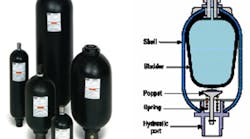Accumulators store energy by compressing a gas, usually nitrogen. This high-pressure gas then forces hydraulic fluid pot of the accumulator whenever system pressure drops below the gas compressed gas pressure. The storing of potential energy and cushioning nature of compressed gas also makes accumulators useful for reducing rapid dynamic behavior of the hydraulic system.
Pulsation absorption — Many pumps deliver power in a pulsating flow. The piston pump, commonly used for its high-pressure capability, can produce pulsations detrimental to a high-pressure system. An accumulator properly located in the system will substantially cushion these pressure variations.
Shock cushioning — If a cylinder or other actuator of a hydraulic system stops suddenly, the rapid change can create a pressure wave that travels back through the system. This shock wave can develop peak pressures several times greater than normal working pressures. An accumulator's gas cushion, properly located in the system, will minimize this shock.
Supplementing pump flow — An accumulator can assist a hydraulic pump in delivering power to the system. The pump routes pressurized fluid to the accumulator during idle periods of the work cycle. The accumulator stores trhis power and makes it available to help drive the load when peak power is needed. This enables a system to utilize a much smaller pump, resulting in savings in cost and power.
Maintaining pressure — Pressure changes occur in a hydraulic system when the liquid is subjected to rising or falling temperatures. Also, pressure may drop due to leakage of hydraulic fluid. An accumulator compensates for such pressure changes by delivering or receiving a small amount of hydraulic fluid. If the main power source should fail or be stopped, the accumulator would act as an auxiliary power source, maintaining pressure in the system.
Standby power — An accumulator can retain pressurized gas indefinitely and release the energy on command. This makes accumulators useful as a standby power source for when power is lost from the prime mover. For example, the accumulator can act as a hydraulic battery to power a hydraulic starter motor of an engine.

